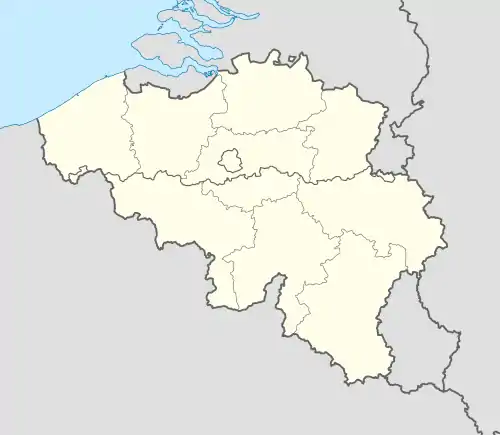Binche
Binche (French pronunciation: [bɛ̃ʃ]; Walloon: Bince, Dutch: Bing) is a Walloon city and municipality located in the Belgian province of Hainaut.[2] On 1 January 2006 Binche had a total population of 32,409. The total area is 60.66 km² which gives a population density of 534 inhabitants per km². Since 1977, the municipality of Binche has gathered the town of Binche itself with seven old municipalities : Bray, Buvrinnes, Epinois, Leval-Trahegnies, Péronnes-lez-Binche, Ressaix and Waudrez.
Binche | |
|---|---|
 Binche, the old city and its surrounding wall | |
 Flag  Coat of arms | |
 Binche Location in Belgium
Location of Binche in Hainaut  | |
| Coordinates: 50°24′N 04°10′E | |
| Country | Belgium |
| Community | French Community |
| Region | Wallonia |
| Province | Hainaut |
| Arrondissement | Thuin |
| Government | |
| • Mayor | Laurent Devin (PS) |
| • Governing party/ies | PS, MR |
| Area | |
| • Total | 60.66 km2 (23.42 sq mi) |
| Population (2018-01-01)[1] | |
| • Total | 33,598 |
| • Density | 550/km2 (1,400/sq mi) |
| Postal codes | 7130, 7131, 7133, 7134 |
| Area codes | 064 |
| Website | www.binche.be |
The motto of the city is "Plus Oultre" (meaning "Further" in Old French), which was the motto of Holy Roman Emperor Charles V, who in 1545 gave the medieval Castle of Binche to his sister, Queen Mary of Hungary. She lavished attention on Binche, which she had rebuilt into Binche Palace under the direction of an architect-sculptor Jacques du Broeucq, remembered today as the first master of Giambologna. The château, intended to rival Fontainebleau, was destroyed by the soldiers of Henry II of France in 1554.
In 2003, the Carnival of Binche was proclaimed one of the Masterpieces of the Oral and Intangible Heritage of Humanity by UNESCO.
.JPG.webp)
History
Binche developed in the Middle Ages close to the Roman Road that connected in Bagacum, the capital of the Nervii, (now Bavay) to Colonia Claudia Ara Agrippinensium, (now Cologne). The road long influenced trade and communication through Binche.
The city was officially founded in the 12th century by Yolande of Gelders, widow of Duke Baldwin III from Hainaut. Their son Baldwin IV fortified the city, which served as a frontier fortress against France. In the 14th century, the city wall was extended to its present size.
The city reached its peak in economic and power when Belgium was under Spanish rule. Binche was the residence of Mary of Hungary, governess of the Netherlands for her brother, Emperor Charles V. She had a magnificent palace built, designed by the architect Jacques Du Broeucq and which was to compete with that of Fontainebleau. Charles V visited Binche in 1549 on invitation from his sister and for this occasion she organized magnificent celebrations.
In 1554 the period of prosperity came to an end as the palace, the city and the surrounding area were plundered by the troops of King Henry II of France. Until the beginning of the 18th century, Hainaut was the site of repeated military conflicts between the kingdoms of France and Spain.
Only with the industrial revolution did prosperity increase again. There were coal mines, whose heaps still shape the landscape today. Added to this were brickyards, tanneries, glaziers, breweries, lime kilns and soap factories. Thousands of people worked at home as top lace makers, cobblers and tailors. The post office and the train station date back to this time.
Notable people
- Gilles Binchois (c. 1400 – 1460), composer
- Berthe Dubail (1911-1984) painter.
See also
- Carnival of Binche, a yearly festival
- La Binchoise, a brewery in Binche
- Fortsas hoax, an incident in Binche in 1840
Notes
- "Wettelijke Bevolking per gemeente op 1 januari 2018". Statbel. Retrieved 9 March 2019.
- Also spelt Binch in some English sources.
External links
 Media related to Binche at Wikimedia Commons
Media related to Binche at Wikimedia Commons- Official site of the city of Binche (in French)
- Union binchoise des Étudiants de Louvain
- Patrimoine du musée International
- Rugbyclub de Binche
- La Binchoise, Belgian Brewery, Binche
